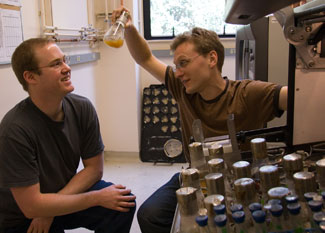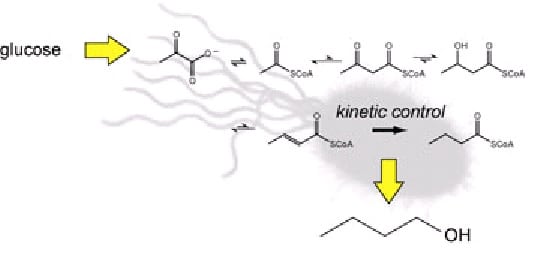Chemists from the University of California (Berkeley) succeeded in engineering a bacterium capable of producing gasoline-like biofuel at a rate ten times the rate of competing bacteria, a breakthrough that could soon provide "green" fuel available for transportation

Chemists from the University of California (Berkeley) have succeeded in engineering a bacterium capable of producing gasoline-like biofuel at a rate ten times the rate of competing bacteria, a breakthrough that could soon provide "green" fuel available for transportation.
Some strains of the bacterium Clostridium naturally produce a substance known as normal butanol (n-butanol), a chemical that many scientists believe could be used as an alternative to diesel fuel or gasoline. While most researchers, including several biofuel companies, genetically modify the bacterium to increase its production capacity, other scientists have taken the enzymes responsible for this reaction out of the bacterium and inserted them into other microorganisms, such as yeast, to turn them into butanol-producing factories. Yeast and the bacterium Escherichia coli, one of the main types of bacteria in the human intestines, are considered organisms that are easy to grow on an industrial scale.
Although with these methods it is possible to produce Escherichia coli bacteria and genetically modified yeast, the utilization of the normal butanol produced is limited to a little over half a gram per liter, a rate significantly lower than the amount for production from deficients.
The researchers used the same enzymatic pathway that exists in Escherichia coli, but they replaced two out of five similar enzymes that appear in other organisms and thus they avoided one of the problems that other researchers encountered: butanol is converted back to its starting materials by the same enzyme that creates it.
The new genetically modified Escherichia coli bacterium produces five grams of butanol per liter, the same amount as the natural clostridium bacterium and a third of the amount produced by the best genetically modified clostridium bacterium known so far, and an amount that is ten times greater than the current industrial microorganism systems.
"We believe that it is easier to use our method and we will improve it even more," explains the researcher
the main one. "The survivors we receive today are close to a state with industrial feasibility."
One of the reasons for the use of microorganism engineering for the preparation of (biological) fuels is the avoidance of toxic by-products obtained in the traditional fossil fuel refining industry, and ultimately, the replacement of these polluting fuels with environmentally friendly biofuels derived from plants.
"Depending on the defined pathway by which an enzyme catalyzes a reaction, it can be forced to move in the required direction by reducing the rate at which the repeated reaction occurs," explains the researcher. "If the reverse reaction is slow enough, then the conversion becomes virtually irreversible, allowing a greater amount of the desired end product to be obtained." The research findings were published in the scientific journal Nature Chemical Biology.


7 תגובות
A. What do the bacteria work on? What substances do they turn into oil? Why won't they end too?
B. The problem with oil is the increase in demand when the supply per day remains the same or fails to climb as quickly. Even if this were true for bacteria there must be limited production capacity relative to the increase in demand.
There is a scientist who claims that the oil comes from bacteria in the depths of the earth and that the oil powers are hiding this information and they are making sure to hide evidence before shipping the crude barrels.
If this is true it means that the oil will never run out and therefore its price should also drop drastically.
Everything is very nice, but what substance does the bacteria "work" on?
If there is no cheap raw material available in adequate quantities that the bacteria can turn into fuel, then from a commercial point of view we have done nothing.
Great news! I heard that there are still some rainforests left, so after we cut them all down there will be enough room to grow plants for bio fuel for at least another ten years! And we can continue to drive cars that run on fuel! You made my day!
What pollution is caused by the burning of normal butanol? Is it significantly lower than gasoline/diesel? Do you need adjustments in vehicles?
Clostridium (if I understood) is a whole family of aerobic (anaerobic) bacteria.
The name of the specific bacteria was not given for some reason.
It was not understood why the new transgenic bacteria based on Escherichia coli is so interesting
According to the article, he achieves: "The same amount of the natural Clostridium bacterium and one third
from the amount produced by the best genetically modified clostridium bacterium known so far".
Unless Escherichia coli operates in a harsher environment than its environment
Clostridium works (that is, more suitable for industrial conditions) - and here is the question
Where is the progress and where is the point?
I don't know how much half a gram per liter of butanol (I assume for one day) is worth in relation to mineral fuels, but I know that at least when talking about algae then even 50 grams per liter per day is still considered unrealistic for biodiesel. I believe that a great deal can be done with the help of biotechnology and that the key is in coupling processes: even if the butanol will not yet be in an economically viable quantity, we need to look for and find by-products of this system with which we can supplement the income. Everyone wants green and some are even willing to pay a little more for it. So a little more is perhaps not so good, but much less as a total fabric of a system with different products - here could be a breakthrough.
For example, after you harvest the butanol, you are left with a lot of other organic matter. What can be done with him? maybe burn? Maybe use it to feed the bee? Maybe recycle it as a food source for the next batches of the engineered bacteria? Coupling! where the big money is.
Greetings friends,
Ami Bachar